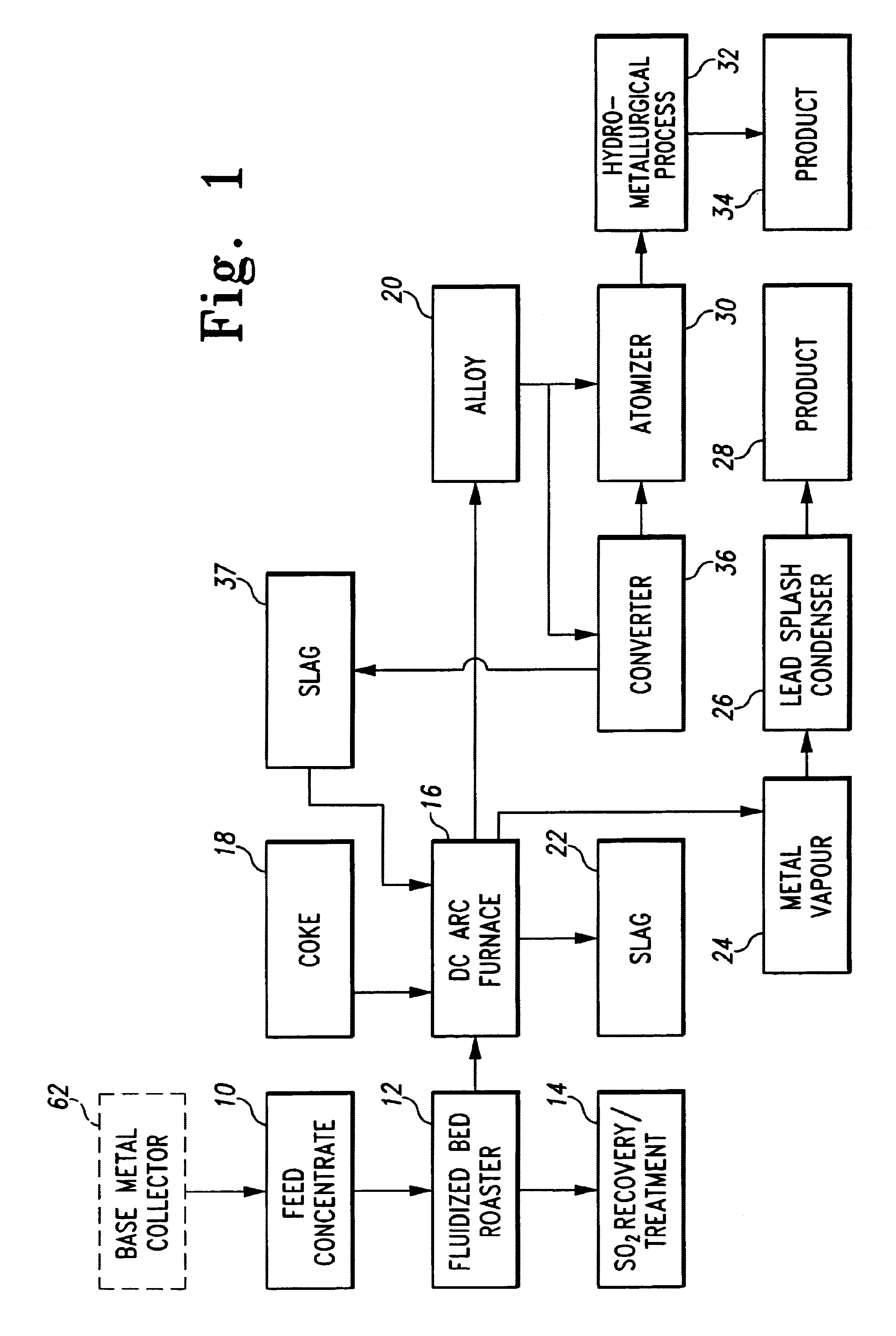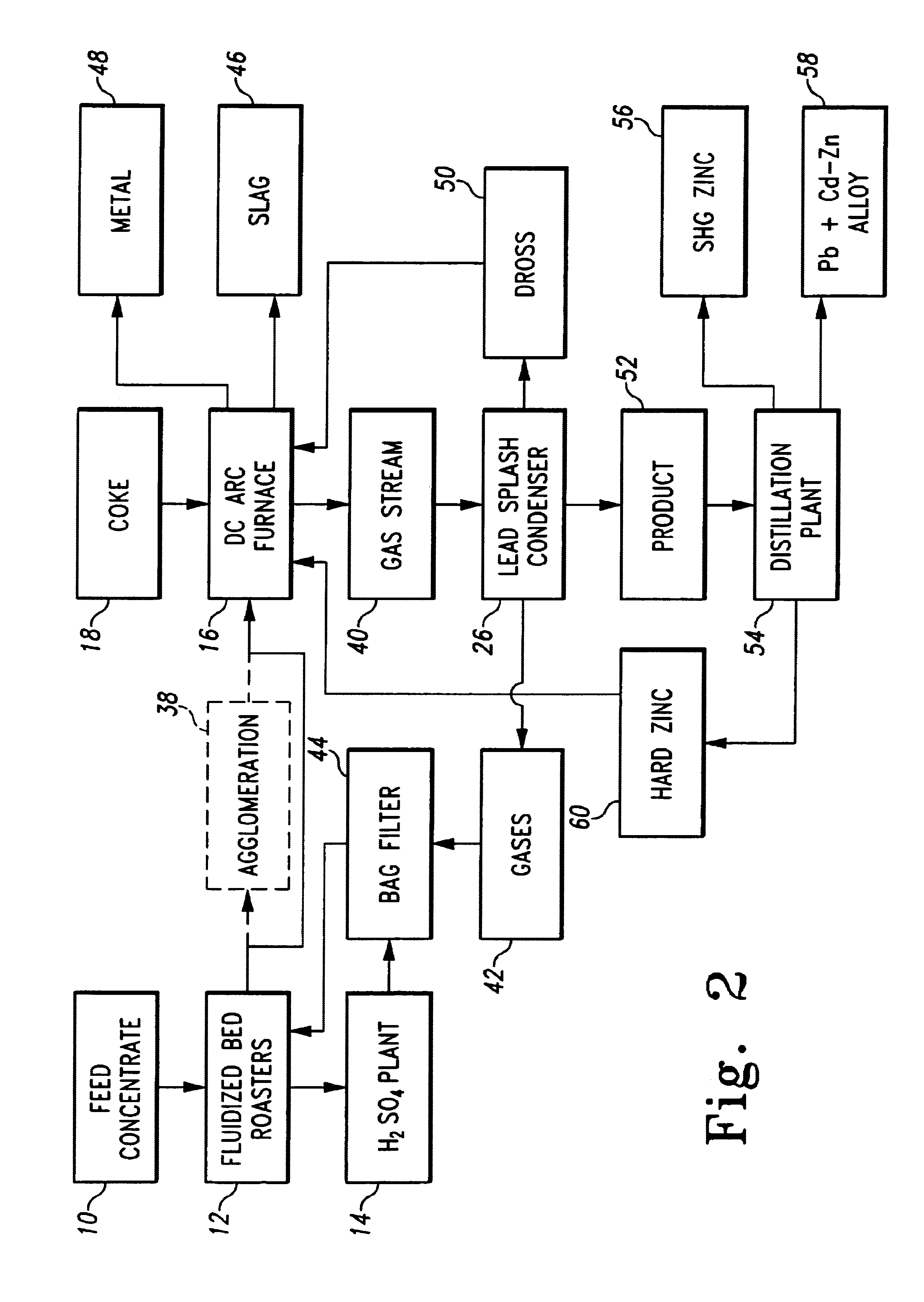Treatment of metal sulphide concentrates by roasting and electrically stabilized open-arc furnace smelt reduction
a technology of open-arc furnace and concentrates, which is applied in the direction of electric furnaces, furnace types, furnaces, etc., can solve the problems of high electrical energy consumption, relative high copper losses in slag, and fragileness, and achieve the effect of improving arc stability and increasing energy losses
- Summary
- Abstract
- Description
- Claims
- Application Information
AI Technical Summary
Benefits of technology
Problems solved by technology
Method used
Image
Examples
example 1
FIG. 6
This Example applies to those situations in which the alloy contains PGMs and valuable base metals. In the first step, the iron and base metals are dissolved, leaving a residue that comprises a PGM concentrate that can proceed to a PGM refinery. Oxidative leaching would normally be used, but non-oxidative leaching may also be used (in which case the air / oxygen supply to the leach would be omitted). Elevated temperature and pressure may be used, either alone or in combination with ambient-pressure leaching. In some cases, elevated pressure may not be necessary. The resulting solution could be passed directly to a copper solvent extraction and electrowinning sequence for copper recovery, or it could be passed to an iron-precipitation stage and then to the copper solvent extraction and electrowinning stage. The raffinate from copper solvent extraction would be neutralised and any remaining iron precipitated, to produce a solution containing mainly nickel and / or cobalt, from which...
example 2
FIG. 7
This Example applies when PGMs are not present in the alloy, for example when the alloy comes from the reduction of converter slag, for the recovery of base metals. Often, this will entail cobalt as the major metal value. In this case, the oxidative leach would be operated so as to solubilise the copper, nickel and cobalt while rejecting all or most of the iron as a hematite or goethite residue. After copper solvent extraction and electrowinning, the cobaltinickel solution would proceed to conventional treatment for the recovery of nickel and / or cobalt.
example 3
FIG. 8
In this Example an atomised alloy from a smelting plant is fed to an atmospheric leach, where the bulk of the iron and nickel is leached in the presence of oxygen and sulphuric acid, at a temperature between 30.degree. C. and 95.degree. C. The copper from the electrowinning spent recycle is cemented in the atmospheric leach and assists in the leaching of the iron and nickel. Conditions for the atmospheric leach were optimised during a laboratory scale test programme. A pilot-scale (100 L) batch atmospheric leach, based on the optimised conditions, was performed on 5.5 kg of atomised alloy. The performance of the pilot-scale batch leach is summarised below.
The leach residence time is set according to the material to limit the leaching of copper while still maintaining high iron and nickel recoveries. Leach residence times of between 5 and 10 hours are required. The optimum leach residence time was exceeded in the test above, such that some copper leaching was observed.
The resid...
PUM
| Property | Measurement | Unit |
|---|---|---|
| temperatures | aaaaa | aaaaa |
| temperatures | aaaaa | aaaaa |
| temperature | aaaaa | aaaaa |
Abstract
Description
Claims
Application Information
 Login to View More
Login to View More - R&D
- Intellectual Property
- Life Sciences
- Materials
- Tech Scout
- Unparalleled Data Quality
- Higher Quality Content
- 60% Fewer Hallucinations
Browse by: Latest US Patents, China's latest patents, Technical Efficacy Thesaurus, Application Domain, Technology Topic, Popular Technical Reports.
© 2025 PatSnap. All rights reserved.Legal|Privacy policy|Modern Slavery Act Transparency Statement|Sitemap|About US| Contact US: help@patsnap.com



